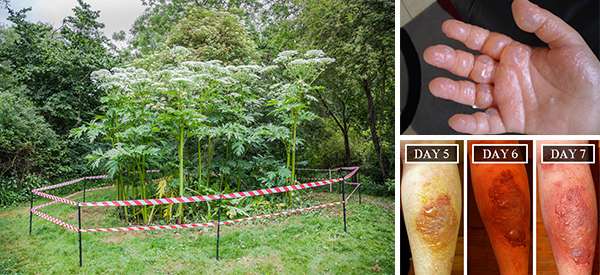
If You See This Plant, Whatever You Do Don’t Touch It!
Giant hogweed (Heracleum mantegazzianum) is a very large plant that buds pretty white flowers, which give it an altogether innocuous look. But, make no mistake touching this plant!
This plant is dangerous both for adults and for kids, but it may present a higher risk for kids as they are more curious.
This valuable information should be taught in schools. There are only 10 plants in North America (excluding fungi) that kids need to know to avoid. So sad that kids aren’t taught basic things like this.
Although part of the Carrot family, the giant hogweed can grow up to 14 feet tall and has a deadly toxic sap!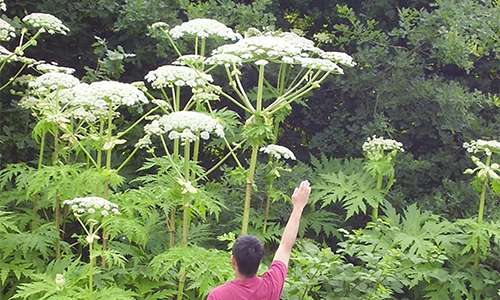 If you brush up against this plant, accidentally break the stem or touch any of its sap that may be on it already, you will get powerful blisters!
If you brush up against this plant, accidentally break the stem or touch any of its sap that may be on it already, you will get powerful blisters!
The stem is quite tall so this is very easy to do and this applies to any part of your body. The stems are green with patches of purple and is a bit hairy, filled with white hairs, so you have an idea of what to avoid.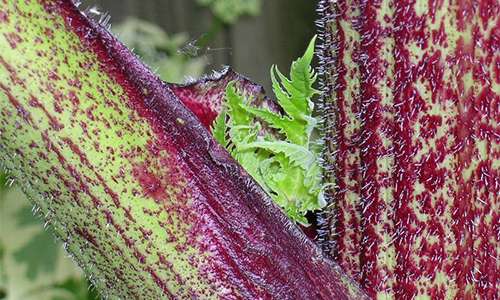
What Will Giant Hogweed Do To You?
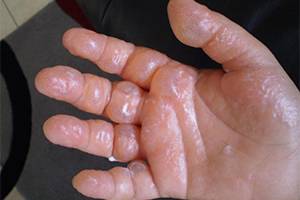 If you come into contact with the plant’s sap, you can expect severe blistering, possible blindness if it comes into contact with your eyes, and possible third degree burns.
If you come into contact with the plant’s sap, you can expect severe blistering, possible blindness if it comes into contact with your eyes, and possible third degree burns.
These effects come from the type of chemicals the plant contains. When these chemicals come in contact with human skin, they dramatically increase the skin’s sensitivity to light.
This can cause blisters that are actually very painful and form within around 48 hours. They can last from anywhere between a few months to six years. If the sap gets in the eye it can cause LONG TERM sensitivity to light.
What to Do if You or Your Child Come In Contact with the Giant Hogweed
The best prevention is of course to avoid it!
But if you come into contact with the plant, you should wash with cold water immediately as the toxic reaction can begin within 15 minutes after contact, and keep the area away from sunlight for 48 hours.
Apply sunblock/sunscreen on the affected area, if you are in an outdoors with no way to get indoors for a while.
If the same sap gets into your eyes, rinse and make sure all of it is out of the eye. Then wear sunglasses to reduce sensitivity.
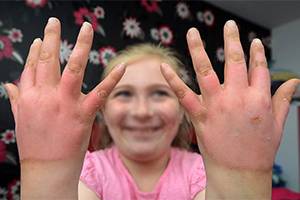
The little girl is from Scotland, but the plant grows as well in USA and Canada.
There were public warnings about the plant and the serious problems caused by coming in contact with it. New York, Maryland, Virginia, Oregon ,Ohio, Washington, Pennsylvania, Michigan and some other states reported sightings of the plant.
How to Get Rid Of This Pest, Giant Hogweed
Well conventional wisdom would say cut it down and maybe spray some weed killer on it. Think again, this will possibly just spread seeds and create a few more toxic plants.
The toxic sap, which causes fear of this plant, may expose you to serious harm.
If you find this plant near your home or on your land, call the EPA (United States Environmental Protection Agency) hotline at 1-800-424-8802 or contact your individual state agency to have it removed, as many countries have flagged it as a pest.
You may also like:
 How to Make Cabbage Bandages to Treat Inflammation and Joint Pain
How to Make Cabbage Bandages to Treat Inflammation and Joint Pain
Similar to Morphine: The Best Natural Painkiller that Grows in Your Backyard (Video)
10 Beautiful Plants That Are Secretly Killing Your Garden
If You See This Weed Growing In Your Yard, Don’t Pick It – Here’s Why

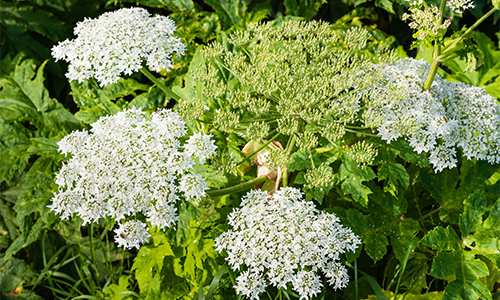
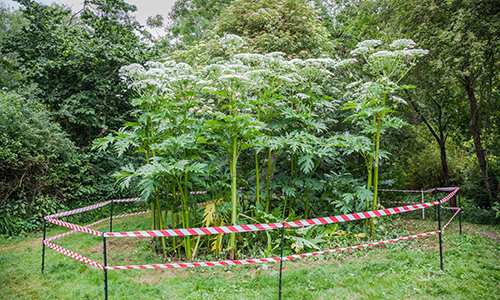
THANK YOU FOR THE HEAD’S UP ON THIS PLANT!! IT’S VERY MUCH APPRECIATED!!
Hi William,
Thank you so much for your comment.
We really appreciate your feedback.
God bless!
Is this also known as poison hemlock? It looks much the same and we just removed it, very carefully, from our farm. We did it before it went to seed. Then poured boiling water and salt on the short stem and ground. This has worked for us previously. Unfortunately, it grows everywhere where we live in western NC.
I am wondering this also
The leaf looks very different from the poison hemlock.
It is definitely not poison hemlock. Poison Hemlock has different looking leaves, they are also “hairless” unlike the hogweed. Hogweed also is a larger plant averaging around 12ft when mature about twice the size of the Poison Hemlock. The flowers are also different, but similar. The Hemlock has small, evenly spaced clusters of white, but the Hogweed has the flower clusters mostly touching in one larger mass without the even spacing between. If it has hairs on the stalk or stems, avoid it. Neither is nice, but contact with the Hogweed is usually MUCH worse.
Yes it is
No. It is not poison hemlock. You can touch poison hemlock with no problem. Just don’t eat it.
Thank you.
Hi Maryla,
Thank you so much for your comment.
We appreciate it.
God bless!
I think I have this plant on my property. Does touching the plant leaves affect the skin (like brushing up against poison ivy) or do you have to come in contact with the sap?
Hi Al Ames,
Thank you so much for your comment.
If you come into contact with the plant’s sap, you can expect severe blistering, possible blindness if it comes into contact with your eyes, and possible third degree burns.
God bless!
Thanks so much. Will be on the look out.
Hi Chuck,
Thank you so much for your comment.
We are happy that the article was useful to you.
God bless!
Thank you
Hi Ann,
Thank you so much for your comment.
We really appreciate it!
God bless!
Very similar to this is Wild Parsnip and Cow Parsnip. These two cause similar issues but the Hogweed is more potent.
Hi BG,
Thank you so much for your comment.
This is so true, Wild Parsnip and Cow Parsnip are very similar to giant hogweed.
God bless!
I knew there had to be an extremely good reason that I DETEST parsnips!! I sat @the kitchen table for (literally!) 2 – 3 HOURS (!) refusing to eat them until it was almost bedtime! When THE statement, “Some child in China would love to have this”, I always told them I would LOVE to address the box & drop it off @ the post office!
Thank You for this important article! I recently purchased your book “ the Lost Book of Herbal Remedies” and noticed that some of the recipes involve the use of alcohol. My husband is sober and can’t take anything with alcohol, is there a substitute for it in these recipes?
Hi I can’t take alcohol. Is there a substitute for it in these recipes? (I saw the post from Jocelyn and couldn’t see the answer you gave.)
Hi Jocelyn,
Thank you so much for your comment.
Although they aren’t quite as potent or long-lasting as alcohol-based tinctures, glycerites are a great option for families. While an alcohol-based tincture will take 6 to 8 weeks, a glycerin-based, non-alcoholic herbal extract takes just 3 days.
God bless!
I have that same effect on women and I think thats why they avoid me.
Hi Skipclair,
Thank you so much for your comment.
We enjoyed your comment, it was really hilarious!
God bless!
Is it also caked Poison Parsnip? We had this same thing growing in Massachusetts when we were living there and the symptoms were very similar. We removed one piece from near our garden “very carefully” because we had seen warnings! Carol
Hi Carol,
Thank you so much for your comment.
Here is an article about the difference between Giant Hogweed and Parsnip:
https://www.strathcona.ca/agriculture-environment/plants/weeds/giant-hogweed-or-cow-parsnip/
God bless!
Is Michigan affected
Hi Margaret,
Thank you so much for your comment.
Giant Hogweed is not widely spread in Michigan.
God bless!
very good article. Can you one on both types of Hemlock. People ask me about water Hemlock many times. And I tell them it smells nasty to me.
Hi Theodore,
Thank you so much for your comment.
Water hemlock may be confused with poison-hemlock because of the similarity in names; however, these two are different plants that cause different types of poisoning. In cases of water hemlock poisoning in humans, contact a poison control center and obtain emergency medical assistance as quickly as possible.
Poisoning results in severe seizures and convulsions that must be controlled to preserve normal ventilation and cardiovascular function.
God bless!
That weed grows all over eastern North Dakota! I never knew how toxic it is! Thank you for this article!
Hi DT,
Thank you so much for your comment.
We really appreciate it.
God bless!
[…] If You See This Plant, Whatever You Do Don’t Touch It! […]
[…] If You See This Plant, Whatever You Do Don’t Touch It! […]
What is the best way to get rid of these plants?